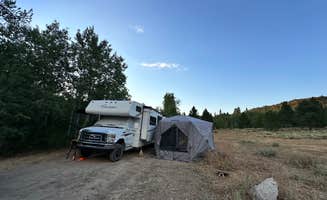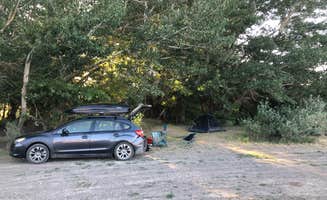Tent camping near Murtaugh, Idaho offers primitive backcountry sites within South Hills forests at elevations between 6,000-8,000 feet. Most sites experience significant temperature drops at night, often 30-40 degrees cooler than daytime highs. Roads leading to remote campgrounds become impassable in spring due to muddy conditions and snow melt.
What to do
Night climbing at Bread Loaves: The rock walls near Bread Loaves Group Campsite face east, creating opportunities for evening or moonlit climbing. "The walls nearby face east and provide an excellent opportunity for some night or moonlight climbing. It also provides a good respite from the wind even if tents in nearby sites are getting blown around and has the best shade in the area!" notes Alan B.
Alpine lake fishing: Hike to multiple mountain lakes from Independence Lakes Campground trailhead. "My son fished with hopes of catching a grayling. He took the winning photo of the lake!" shares Colette A. The lakes are stocked annually with fish and provide mountain views at higher elevations.
Mountain trail systems: Many trails connect campgrounds to alpine areas. "Past the 3rd lake you are able to hike up to the top towards the cliff rocks where you can see the view down the lakes where it loops back down to the 2nd lake," explains Vanessa H. Trails range from moderate 2.5-mile routes to challenging mountain summit paths requiring proper hiking boots.
What campers like
Seclusion from crowds: Many campsites offer isolation from other campers. James C. from Twin Sisters Group Campsite describes "Splendid isolation... Dark, quiet and starry at night with long views to the south. Lots to explore in locale." Many primitive sites receive minimal visitors, especially mid-week.
Natural sounds: Creeks and wildlife provide natural soundscapes at several sites. "Loved hearing the creek as we tucked in for the night," notes Colette A. about Independence Lakes Campground. Running water sources near campsites enhance the overnight experience while providing cooling effects during summer months.
Wildlife viewing: Several campgrounds feature ponds and springs attracting birds and wildlife. "Situated by a pond with lots of birds made our stay very peaceful," reports one McClendon Spring visitor. Morning and evening hours offer the best wildlife viewing opportunities at watering sources.
What you should know
Road conditions: Access to most sites requires traveling rough dirt roads. For McClendon Spring Campground, Rachele V. advises, "Don't use Apple Maps. Google will get you there on the easiest road." Another camper notes: "About 3 1/2 miles on a semi maintained gravel road. Lots of cows."
Limited amenities: Prepare to be self-sufficient with water and supplies. "This is a typical BLM site. Be prepared with everything you might need," suggests Maureen F. Most sites offer vault toilets but no potable water, requiring campers to bring adequate supplies.
Seasonal access considerations: Higher elevation sites have limited accessibility windows. "This campground needs a high clearance vehicle to reach and is best visited in late summer fall as it is very marshy there earlier in the year," explains Alan B. Snow can block access before June and after September at many locations.
Tips for camping with families
Equipment transport planning: Some sites require walking gear from parking areas to campsites. At Bread Loaves Group Campsite, Angela S. mentions: "If you have a ton to pack...you may not like this site." Bring collapsible wagons or backpacks to transport gear from parking areas to walk-in sites.
Temperature preparation: Pack appropriate clothing layers for dramatic temperature swings. "It was a good 10 degrees cooler and cooled off quickly when the sun went down," reports Amanda M. about Bear Gulch. Children particularly need extra insulation as temperatures often drop below 40°F even during summer nights.
Trail difficulty assessment: Research trail conditions before hiking with children. For Independence Lakes, Vanessa H. shares: "The hike up to the lakes is dog friendly and baby carrying friendly." Most trails gain significant elevation, with the first mile typically being the easiest section.
Tips from RVers
Vehicle clearance requirements: Standard vehicles struggle on many access roads. Cody E. warns about Independence Lakes: "If my trailer was not lifted we would have had issues." Most RV-accessible sites require high-clearance vehicles and compact trailers under 25 feet.
Limited turning radius: Many camping areas have restricted space for larger vehicles. Kurt G. notes about McClendon Spring: "Plenty of room to turn around," but this is uncommon at most primitive sites. RVers should research turning areas before attempting narrow forest roads.



